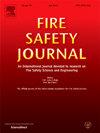Flame interaction effects on the flame structure of twin parallel rectangular fires
IF 3.4
3区 工程技术
Q2 ENGINEERING, CIVIL
引用次数: 0
Abstract
The present study experimentally investigates the flame interaction mechanism of twin parallel rectangular fires, with a particular focus on the evolution of flame structure. A series of propane-fueled flame tests are conducted with varying burner aspect ratios (L/W), burner spacings (S), and heat release rates (). Temperature and velocity distributions, as well as the geometrical parameters of the flames, are measured and discussed. Results show that the flame length of the twin fires increases monotonically as S decreases within a specific range of L/W and , where the occurrence of flame merging plays a significant role. As L/W or continues to increase, the flame length first rises and then declines as S decreases, reflecting the impacts of air entrainment restriction. A merged twin flame can be divided into three distinct regions based on the radial distribution of the flame temperature: the merging region, the transition region, and the fully merged region. The radial distribution demonstrates a bimodal distribution in the merging region, an unimodal yet non-self-similar distribution in the transition region, and a self-similar distribution in the fully-merged region. Furthermore, it was observed that both temperature and velocity half-width of the twin flames increase as S decreases within specific ranges for L/W and . As L/W or continuously increases, the height at which twin flames merge approaches their base, resulting in an expansion of the flame and subsequently leading to an increase in temperature or velocity half-width as S increases. The axial temperature or velocity of the non-merged twin flames increases as S decreases. As flame merging occurs, the flow from each twin flame converges at a merging height; this convergence facilitates an increase in axial velocity. At this point, higher values of S create additional room for air entrainment before flame merging occurs, further enhancing the axial velocity of the merged flame. This trend becomes increasingly pronounced as increases.
火焰相互作用对双平行矩形火焰火焰结构的影响
本文通过实验研究了双平行矩形火焰的火焰相互作用机制,重点研究了火焰结构的演变。在不同的燃烧器长径比(L/W)、燃烧器间距(S)和热释放率(Q˙L)下进行了一系列丙烷燃料火焰试验。测量和讨论了火焰的温度和速度分布以及火焰的几何参数。结果表明:在一定的L/W和Q˙L范围内,火焰长度随S的减小而单调增加,其中火焰合并的发生起着重要作用;随着L/W或Q˙L的增加,火焰长度随S的减小先上升后下降,反映了夹带气流限制的影响。根据火焰温度的径向分布,可以将合并的双生火焰分为三个不同的区域:合并区、过渡区和完全合并区。径向分布在合并区表现为双峰分布,在过渡区表现为单峰但非自相似分布,在完全合并区表现为自相似分布。在一定的L/W和Q˙L范围内,随着S的减小,双火焰的温度和速度半宽均增加。随着L/W或Q˙L的不断增加,双生火焰合并的高度接近其底部,导致火焰膨胀,随后随着S的增加导致温度或速度半宽的增加。未合并双火焰的轴向温度或速度随S的减小而增大。当火焰合并发生时,每个双火焰的流动在合并高度收敛;这种收敛有利于轴向速度的增加。此时,更高的S值为火焰合并前的空气夹带创造了额外的空间,进一步提高了合并火焰的轴向速度。随着Q˙L的增加,这一趋势变得越来越明显。
本文章由计算机程序翻译,如有差异,请以英文原文为准。
求助全文
约1分钟内获得全文
求助全文
来源期刊

Fire Safety Journal
工程技术-材料科学:综合
CiteScore
5.70
自引率
9.70%
发文量
153
审稿时长
60 days
期刊介绍:
Fire Safety Journal is the leading publication dealing with all aspects of fire safety engineering. Its scope is purposefully wide, as it is deemed important to encourage papers from all sources within this multidisciplinary subject, thus providing a forum for its further development as a distinct engineering discipline. This is an essential step towards gaining a status equal to that enjoyed by the other engineering disciplines.
 求助内容:
求助内容: 应助结果提醒方式:
应助结果提醒方式:


